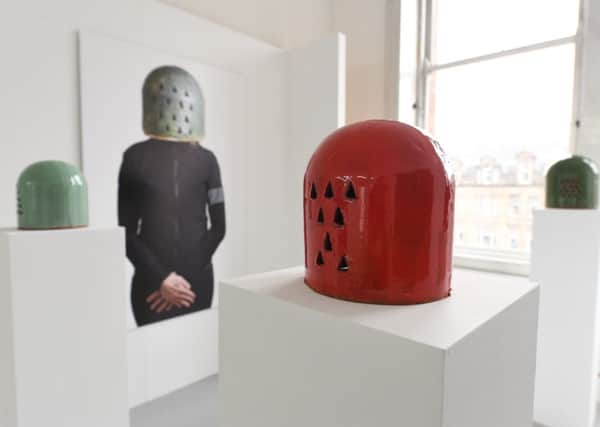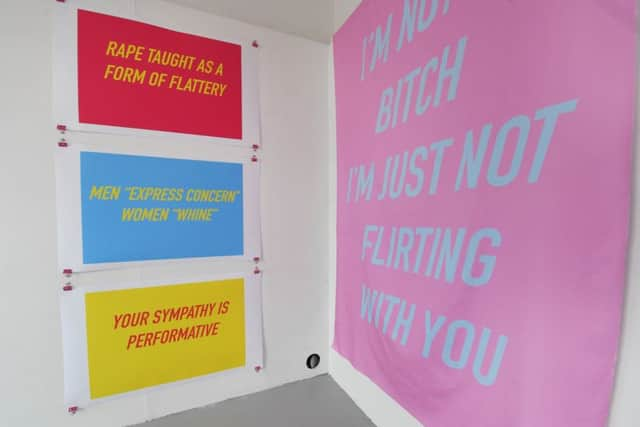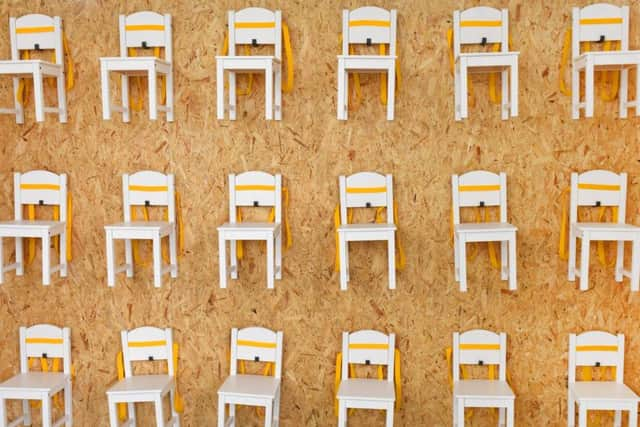Art reviews: Undergraduate and MFA Degree Shows, Glasgow School of Art


Glasgow School of Art Undergraduate Degree Show, Tontine Building, Glasgow ****
Glasgow School of Art MFA Degree Show, Glue Factory, Glasgow ****
Advertisement
Hide AdEach one of these shows is a distillation of four years of study and exploration, and in most cases we can only scratch the surface. Background information can help, but, as is customary at GSA, little is provided.


Perhaps it’s a reflection on the pressure of degree shows, or perhaps of life in general, but several students have created spaces set aside for rest and relaxtion. Skyler Ridewood has created an impressive room of coloured light which changes in response to mood and movement, as well as being used to house drawings and sculpture. Giles Watkins has made a space for taking tea, complete with handmade ceramic tea pot, cups and seats, hung with attractive screens.
Eleanor Rodwell goes further, inviting the viewer to lie down on a comfortable-looking couch and listen to their own heartbeat in a moment of reflection (I hope she’s also on hand to rouse anyone who falls asleep). Cameron McCracken’s space is about creating room for conversation in a world where most of us are more interested in engaging with our phones.
A recurring theme throughout the show is an interest in re-engaging with the physical in a world which is often mediated by the intellectual or virtual. Ella Mottram, who has spent some of her time at art school doing movement workshops with children, has created an exercise regime, D.A.N.D. (Dance A New Day) with this in mind. Rosa Klerkx’ slow film of a woman dancing in a derelict building becomes a quietly meditative experience.
Natalie Morgan Klein’s large abstract sculptures explore the contrasts between the curved geometry of the human body and the harsher lines and angles of the city our bodies have to navigate. Gemma Jones uses her own body in performances (made into films) which explore space and colour. Several artists are concerned with the lengths we go to beautify our bodies: Holly Osborne paints people at the gym, and Caitlin Higgins builds sculptures which look like work-out machines.


Looking for the beautiful and surprising within the mundane is another recurring theme. Rebecca Thomson looks for the poetry in supermarket receipts, printing them large-scale on fabric to make banners. Laura McLean does something similar as a photographer, finding the beauty in plastic bags full of fruit and the geometry of vegetable boxes.
Advertisement
Hide AdPhyllis McGowan works transformatively with the domestic by creating ceramic sculptures which look like components of medieval armour while referencing household objects: the helmets based on cheese-graters are particularly effective. However ridiculous this sounds, the work has a restrained seriousness, demonstrating an appreciation of form as well as an ironic “call to arms”.
Several artists take on #MeToo themes. Lucy Lamort’s work in text, banner and film is the most confrontational. Molly Dearie looks at the use and abuse of women in the context of the history of art, while Molly Hankison is concerned with presenting women thoughtfully and sympathetically, allowing their voices to be heard in her accompanying texts.
Advertisement
Hide AdTo see women empowered in art schools is always positive, but the extent to which they now outnumber their male counterparts is a concern. Meanwhile, the men, too, have plenty to say. David Whitelaw asks questions about the extent to which the individual is “known” to the state in contemporary society. Robert Mercer has created an intriguing body of work in photography and sculpture using found balls of all types, including an inventive mobile of the solar system. Gavin Reid’s show is packed with ideas and humour, from Dianetics to George Fornby cassettes.
Several artists explore what it means to live in cities. Malcolm Mackenzie is a photographer who looks at how the countryside has become a refuge for city people who, nevertheless, understand little about what it means to live there. His image of Buachaille Etive Mor towering over a city at dusk is one of the stand-outs of the show. Li Chen is more of a flaneur, creating paintings and neon sculptures which evoke cities, both in Europe and in the Far East. Marina Renée-Cemmick paints the hard-hatted, hi-vis-suited workers we so often overlook who keep our cities running.
And there are plenty of students who stand out simply because of how they use their chosen medium, and the thoughtful, inventive ways in which they approach their subjects: photographers Flannery O’Kafka and Natalia Poniatowska; Fenella Gabrysch, who has created a sensitive dual-screen film about migration, identity and family; Megan Trueman, showing beautiful ceramics which pose questions about craftsmanship, and whether imperfection can be beautiful; and Katarzyna Rymanis Murawska, who has made a bird out of motor parts.
Finally, Rosa Quadrelli invites us into a world of her imagination, beautifully realised in drawings and sculptures, like a haunted children’s story. Even after more than 100 artists, her work still has power to stand out as one of the highlights of the show.
Things take a more leisurely pace at the Glue Factory, which has become the established home of the annual show for GSA’s prestigious postgraduate Master of Fine Arts (MFA) course, which attracts artists from all over the world. It’s a spacious, versatile venue, while still oozing a kind of poetic dereliction.
It’s the ideal place, for example, to construct a steam organ, as Maria Gondek has done, the product of months of research and making, which whistles and cranks its way to an impressive, dripping crescendo. By contrast, Sandy Harris has battled with this rough-edged, chilly space to create an installation which is comfortable and welcoming.
Advertisement
Hide AdAmbitious feats of invention are a feature of this year’s show: Giulia Lazzaro has built herself a bicycle (or “bicyclette”) which she and a friend will demonstrate using a miniature indoor “Cote d’Azur” track. Jamie Cooper has invented a language, which he displays in panels, sculptures and a teaching video. Jeanne Tullen has created an app which tracks her every movement for the duration of the show.
Several of the students have collaborated on a performance, Victorian Workout, choreographed by Elina Bry and Megan Clark. I was disappointed not to witness it in full, but Clark’s impressive costumes – think contemporary sportswear spliced with sculpted Victorian womenswear – and the set by Corinna D’Schoto are permanent exhibits.
Advertisement
Hide AdOther must-sees include Sarah Louise Keber’s paint sculptures, Mathew Parkin’s film based in and around his late grandmother’s house and Jaxton Su’s models of volcanos, islands and icebergs. With 24 graduating students from all over the world, the MFA is – in more than one way – a world in miniature.
The Glasgow School of Art Undergraduate and MFA degre shows both run until 8 June